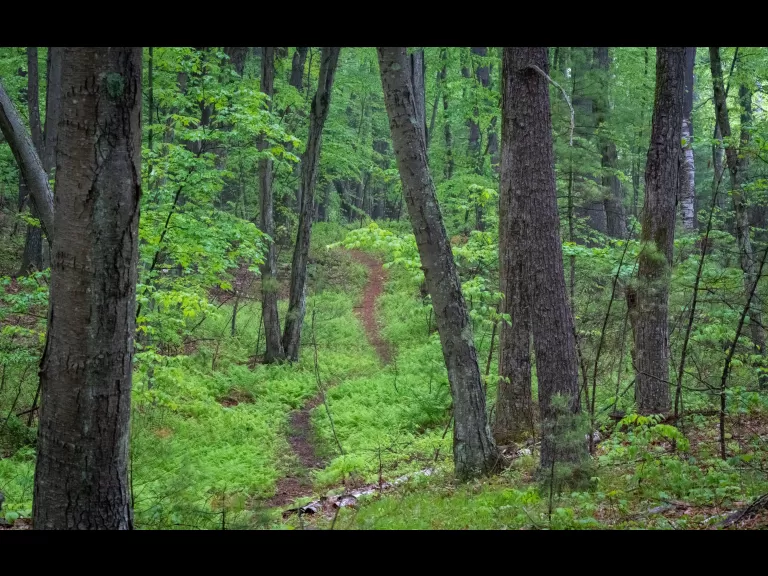Habitat Management at Smith Conservation Land
Ever since our 2019 acquisition of the Smith Conservation Land, the SVT Stewardship staff has been working to fight Asian bittersweet and other non-native invasive plants that have overtaken some of the habitats. Our goal is to make room for native plants to germinate and regrow.
Update June 2025: SVT invited botanist Ted Elliman to join us as we toured the property and assessed our progress. We were delighted by what we found!
Invasive plant abundance is noticeably low (less than 5% in most areas), and a great diversity of native plants are growing, including American elm, sugar maple, black cherry, winter berry, choke cherry, joe pyeweed, and boneset. See Great Success at Smith.
Project Overview
The Smith Conservation Land in Littleton has outstanding conservation values: It hosts multiple habitat types, contains three high-quality vernal pools, and is considered a high-priority area for protection by the state’s BioMap2 ranking system.
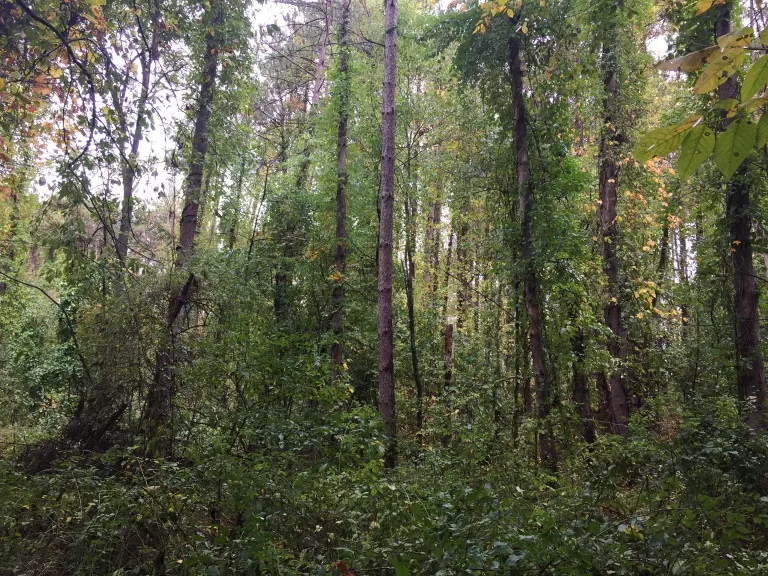
When SVT purchased 48 acres of the Smith property in Littleton in 2019 (the Town of Harvard purchased the 12 acres on its side of the town line), aggressive invasive plants had severely compromised its habitat values. Most notably, Asian bittersweet had spread across 22 acres, strangling trees and displacing all other vegetation in its path. The Smith land also had a large stand of red pine and European tamarack trees, neither of which are native. (See top photo at right.)
SVT developed a multi-year management plan to tackle the invasive plants and restore native vegetation and habitats. We employ a variety of techniques to control invasive plants. We pull, excavate, and smother invasive plants, and we are tracking the results of these various manual methods. We also carefully applied herbicides to Asian bittersweet over a three-year period in some management areas.
The Smith Invasives Management Map illustrates the layout of the various management areas. No herbicides were used in the 50-ft wetland buffers or in the residential and private well buffers. In March 2023, SVT hired a logger to remove the dying red pine and non-native tamarack trees.
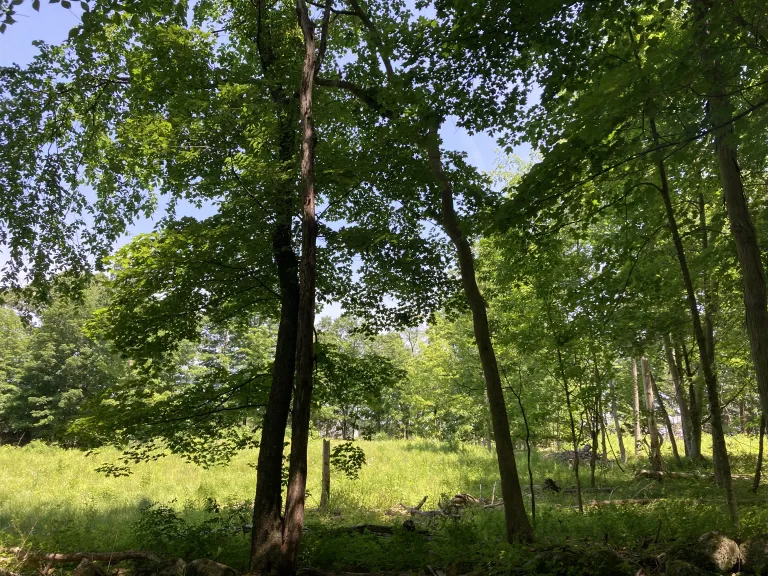
We are pleased that our work is yielding great results. A high diversity and abundance of native plants are thriving and invasive plant cover is very low (less than 5%) in most management areas. (See bottom photo at right, taken from approximately the same spot as the top photo.)
Native plants include sugar maple, American elm, black cherry, winter berry, American hazelnut, choke cherry, joe-pye weed, boneset, and St. John’s-wort. We also hope to see an increase in the abundance and diversity of native insects, including moths, butterflies, and native bees.
We are monitoring our progress in a variety of ways:
- We have set up long-term vegetation monitoring plots and photo-point locations.
- We conduct an annual breeding bird survey.
- We hosted a bioblitz to catalog the plants and animals at Smith when we acquired the property in 2019, and we conducted a second bioblitz in spring 2025.
- We are recruiting volunteers to make observations of birds, insects, and plants throughout the season and over the long-term using a special project that we have set up in iNaturalist.
SVT works with both the Littleton Conservation Trust (which owns a conservation restriction over the entire Smith Conservation Land) and experienced ecologists to ensure we are using environmentally sound and effective methods. We addressed concerns that area residents had about the impact of herbicide treatments, and our plans were approved by both local and state authorities.
The Smith Conservation Land is also the site of a popular trail that SVT and Littleton Conservation Trust maintain for public enjoyment. The trail has remained open throughout the project, although there are occasional trail closures that are posted at the trail head.
Project Updates
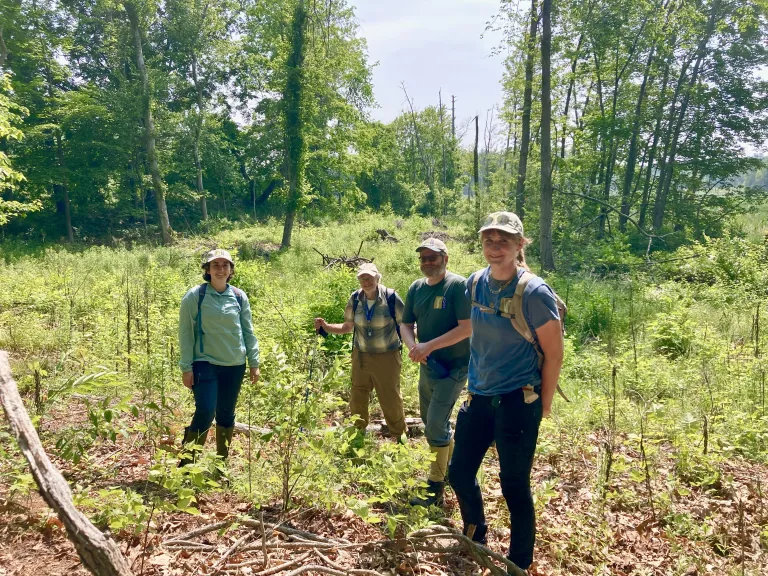
June 2025
The SVT Stewardship staff invited Ted Elliman, a well-regarded local botanist, to join us as we assessed the habitat-management areas. We needed to monitor the results and adjust our tactics as needed.
We were thrilled with what we found. Invasive plant abundance is noticeably low (less than 5% in most areas), and a great diversity of native plants are growing, including American elm, sugar maple, black cherry, winter berry, choke cherry, joe pyeweed, and boneset.
The results so far are fantastic, and we do not need to do any additional seeding or planting at this time. No adjustments needed!
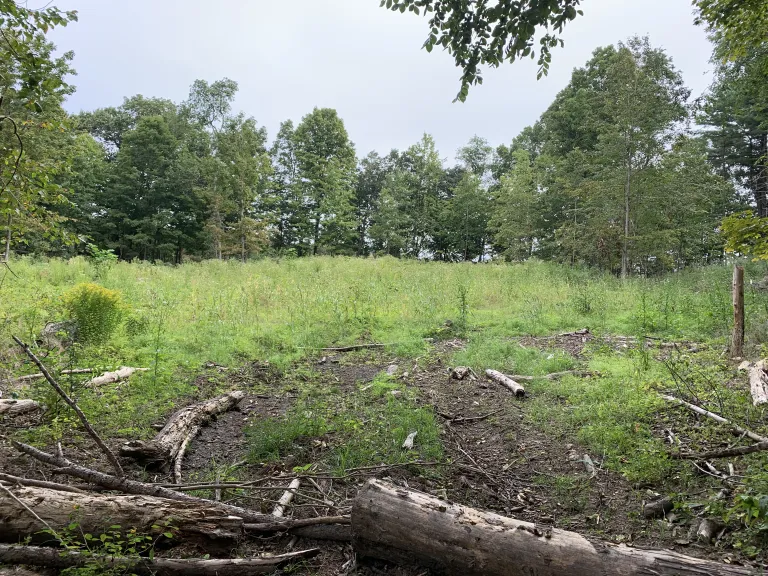
September 2024
We are pleased to report that our combination of manual and herbicide control of Asian bittersweet is working well. Even after the late winter logging and opening up large areas to sun, there has been surprisingly very low regrowth of bittersweet.
In September, our contractor conducted the third round of spot foliar treatment in Units 1, 2, and 5 and also conducted the second round of treatment in Units 3 and 4. Manual control efforts will continue. (These treatments were made possible in part by ghttps://www.nrcs.usda.gov/rants from the Community Foundation of North Central Massachusetts and the USDA Natural Resources Conservation Service.)
Please see our annual progress report completed September 2024.

Fall 2022
SVT developed a comprehensive management plan for the control of invasive plants. We are implementing various control techniques to compare their rates of success and the resources they require.
SVT established two demonstration plots in the 100-foot wetland buffer zone of the red pine plantation (Management Unit 1). In one plot, we are excavating the roots and attempting to completely remove the bittersweet. In the second plot, we are cutting all bittersweet vines two to three times per year.
Throughout the growing season, SVT staff, contractors, and volunteers excavate Asian bittersweet roots in the 50-foot buffer zone of the wetlands in the Residential Buffer of the red pine stand and the European tamarack stand (Management Unit 2).
SVT staff laid down cardboard and wood chips over an area in the southeast corner of the property in an attempt to smother all vegetation, including any bittersweet that is resprouting. The goal is to kill existing vegetation and eventually to put down a native seed mix.
SVT hired Bay State Forestry Service to conduct herbicide applications to Asian bittersweet in Management Units 1, 2, and 5. This has included cut-stump and foliar applications. Backpacks with handheld sprayers have been used to carefully target only the bittersweet and some other invasive shrubs. This treatment was expanded to Units 3 and 4 beginning in late Fall 2022.
Project Documents and Background Research
As part of the approval process, we conducted extensive research and compiled several reports and updates, as listed below:
- Smith Invasives Management Map, September 2021
- Habitat Management Update, July 2021
- Smith Invasives Control Map - Closeup of Pine Stand, July 2021
- Risk Assessment, June 2021
- SVT Letter to Littleton Select Board, December 11, 2020
- SVT Letter to Littleton Select Board, December 3, 2020
- Invasive Plant Tactics, October 2020 (pdf)
- Partial Herbicide Literature Review, October 2020 (pdf)
- Accompanying Bibliography to Literature Review, October 2020 (pdf)

